#yoshinogari
Explore tagged Tumblr posts
Text
Aya at Yoshinogari.

Yoshinogari (吉野ヶ里 遺跡, Yoshinogari iseki) is the name of a large and complex Yayoi archaeological site in Yoshinogari and Kanzaki in Saga Prefecture, Kyūshū, Japan. According to the Yayoi chronology established by pottery seriations in the 20th century, Yoshinogari dates to between the 3rd century BC and the 3rd century AD. However, recent attempts to use absolute dating methods such as AMS radiocarbon dating have shown that the earliest Yayoi component of Yoshinogari dates to before 400 BC. (Sourced from Wikipedia)
#touhou project#東方Project#射命丸文#shameimaru aya#tegaki_dt#tegakidraw#drawn in one hour at night#深夜の真剣お絵描き60分一本勝負#koubudraw#historical site#yayoi culture#yoshinogari#crow#camera#my art
54 notes
·
View notes
Text
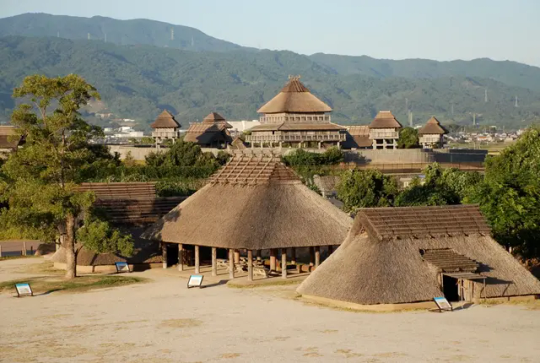
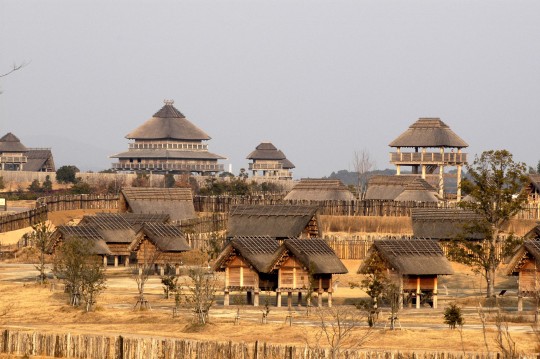
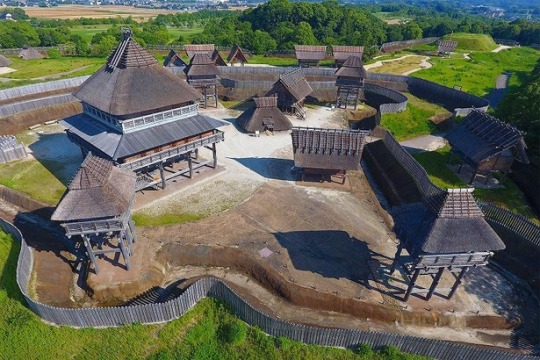
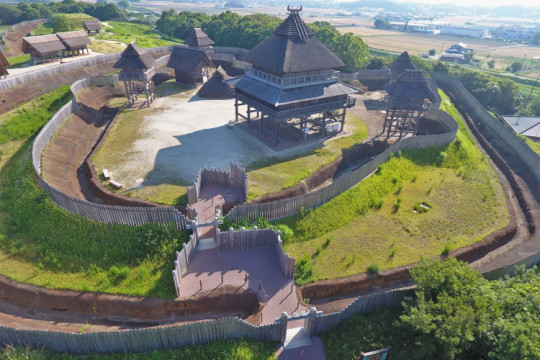
Sean bienvenidos, japonistasarqueológicos, a una nueva entrega de arqueología nipona, una vez dicho esto pónganse cómodos qué empezamos. — En la publicación anterior estuvimos hablando de las ruinas de Yoshinogari, que datan del período Yayoi (300-250) pero en este caso del Yayoi tardío y se localizan en la prefectura de Saga. Esta vez vamos a profundizar un poco más en dicho yacimiento. En la década de 1928-1986 y hasta el presente se han estado hallando restos arqueológicos nuevos. Pero las excavaciones y las investigaciones empezaron en 1928, esta fecha corresponde a la era taisho, también se realizaron excavaciones en Fukuoka la prefectura vecina, principalmente ligados a dos temas, la agricultura y la innovación industrial. En la prefectura de saga, se encontraron vasijas del periodo Yayoi, hasta del periodo Nara, hay que entender que el lugar ha podido ser utilizado en periodos históricos simultáneos, desde la prehistoria hasta nuestros días, como ya mencionamos anteriormente, el yacimiento se localiza cerca del mar de Ariake. A 3 kilómetros nos encontramos las ruinas de Mitsunagata, que estaría cerca de la puerta del parque arqueológico. - En la década de los años 50, se desentierran en las zonas de cultivos, ataúdes de tinajas. En 1928 aparecen: brazaletes de conchas y cuencos de vidrio. Pero no será hasta la década de los años 70 cuando se hacen excavaciones a gran escala, inclusive prospecciones, al noreste de Yoshinogari en las que se encontraron, espejos de bronce y armas de hierro. Se hallaron restos de edificios que se creen que son almacenes de piso elevado. 1980-1982, se excavó arroz carbonizado, esto nos permitirá saber cuál era la dieta y la procedencia del mismo. En 1986, por motivos industriales y por el canal de agua en la prefectura de Saga que comunica el río Chikugo, hasta el río Kase, esto desentierra restos de fosos y huecos de postes de madera. — Espero que os haya gustado y nos vemos en próximas publicaciones, que pasen una buena semana. - 日本の考古学者の皆さん、日本の考古学の新しい記事へようこそ。そうは言っても、気を楽にして始めましょう。 — 前回は、弥生時代(300~250年)、今回は弥生後期、佐賀県にある吉野ケ里遺跡についてお話しました。 今回はこの預金についてもう少し詳しく掘り下げていきます。 1928 年から 1986 年の 10 年間と現在に至るまでに、新しい考古学的遺跡が発見されています。 しかし、発掘調査が始まったのは大正時代にあたる1928年で、隣県の福岡でも主に農業と産業革新という2つのテーマに沿った発掘調査が行われました。 佐賀県では弥生時代から奈良時代の器物が出土しており、先史時代から現代に至るまでの同時期に使われていた可能性があることは、前述したとおりです。有明海の近く。 3キロほど離れたところに、遺跡公園のゲート付近にある三長田遺跡がある。 - 50年代の10年間に、栽培地域で壺の棺が発掘されました。 1928年に貝殻のブレスレットとガラスのボウルが登場しました。 しかし、吉野ヶ里の北東で測量を含む大規模な発掘が行われ、青銅鏡や鉄製の武器が発見されるのは70年代の10年になってからである。 高層倉庫とみられる建物跡が見つかった。 1980年から1982年にかけて焦げた米が発掘され、その食性や起源を知ることができます。 1986年、産業上の理由と、筑後川から嘉瀬川につながる佐賀県の水路の堀と木の柱穴の遺跡が発掘されました。 — 気に��っていただければ幸いです。今後の出版物でお会いしましょう。良い一週間をお過ごしください
Welcome, Japanese archaeologists, to a new installment of Japanese archaeology, having said that, make yourself comfortable and let's start. — In the previous post we were talking about the Yoshinogari ruins, which date from the Yayoi period (300-250) but in this case from the late Yayoi and are located in the Saga prefecture. This time we are going to delve a little deeper into said deposit. In the decade of 1928-1986 and up to the present, new archaeological remains have been found. But the excavations and investigations began in 1928, this date corresponds to the Taisho era, excavations were also carried out in Fukuoka the neighboring prefecture, mainly linked to two themes, agriculture and industrial innovation. In the prefecture of saga, vessels from the Yayoi period to the Nara period were found, it must be understood that the place could have been used in simultaneous historical periods, from prehistory to the present day, as we mentioned above, the site is located near of the Ariake Sea. 3 kilometers away we find the ruins of Mitsunagata, which would be near the gate of the archaeological park. - In the decade of the 50s, coffins of jars were unearthed in the cultivation areas. In 1928 they appear: shell bracelets and glass bowls. But it will not be until the decade of the 70s when large-scale excavations, including surveys, are made northeast of Yoshinogari in which bronze mirrors and iron weapons were found. Remains of buildings believed to be high-floor warehouses were found. 1980-1982, charred rice was excavated, this will allow us to know its diet and origin. In 1986, for industrial reasons and for the water channel in Saga Prefecture that connects the Chikugo River, to the Kase River, this unearths remains of moats and wooden post holes. — I hope you liked it and see you in future publications, have a good week.
#日本#韓国#考古学#遺跡#佐賀県#九州#歴史#先史#新石器時代#文化#吉野ヶ里遺跡#地理#弥生時代#有明海#唐津市#鍋岳遺跡#ユネスコ#Japan#Korea#Archaeology#Ruins#Saga Prefecture#Kyushu#History#Prehistory#Neolithic Age#Culture#Yoshinogari Ruins#Geography#Yayoi Period
46 notes
·
View notes
Text




Announcement for tomorrow's edition of "SHOW Channel".
"SHOW Channel" takes a one-night, two-day trip to Kyushu, where the variety show dives into the world-famous semiconductor factory for the first time and learns about the active Aso volcano.
The programme features Sakurai Sho, Yoshimura Takashi ("Heisei Nobushi Kobushi"), Kotoge Eiji ("The Bikings") and Shin'ichi Hatori.
The first stage is the Yoshinogari ruins, ruins typical of the Yayoi period. Even Sakurai, who is infiltrating for the first time, and Yoshimura, who is usually an avid history buff, seem confused, saying, "I don't understand anything about the Yayoi period". Hatori can't contain his excitement and says, "Yayoi is magnificent, it's the most mysterious era", and explains the highlights of the ruins. Kotoge tells him, "Let's go and tell him" as he makes his way inside.
The village is surrounded by a wooden fence, and there is a menacing atmosphere as if it is defending itself from an outside enemy. It is said that wars often broke out during the Yayoi period, and the ruins of Yoshinogari, which performed a defensive function to protect the village from foreign enemies, were chosen as one of the hundred best castles in Japan as the oldest castle. Sakurai, who imagined the Yayoi period = "an idyllic rice-growing landscape", was quickly captivated by the mysterious enchantment and said: "My image of Yayoi is completely different!"
In the southern inner fence, the area where the leaders of the village are said to have lived, there are many modern objects of the time that are said to have been brought from China during the Three Kingdoms period, such as as as a watchtower and an equestrian platform for observing the surroundings from the "Novel of the Three Kingdoms". Yoshimura was excited and said: "The knowledge of the time when the romance of the three kingdoms was fiercely fought over is here!" What great discovery of the century, made at the ruins of Yoshinogari thirty-one years ago, disproves conventional wisdom?
"The Northern Inner Wall", where the most important people lived, was more rigorously defended than the Southern Inner Wall, with "staggered entrances and exits", as in the Sengoku period, so that it was not easily breached. "The Main Shrine", standing in the centre, is a prestigious place where village leaders gathered and held meetings. When Sakurai and his colleagues go inside, they are welcomed by the leaders and the man who holds the meeting in a ceremonial manner. What was talked about in the main temple, why the Yoshinogari ruins were called Yamataikoku, and the truth about the Yayoi period that will be revealed in two thousand years. In addition, we will also enter the ‘mysterious area’ where excavations are now underway.
On the second day, the company headed to Mount Aso, which is visited by more than one million people a year. The main attraction is the world's largest caldera, formed by an eruption ninety thousand years ago and measuring twenty-five kilometres north-south and eighteen kilometres east-west. Star Kumamoto Kumamon, who greets Sakurai and his colleagues, teaches them, "What is a caldera?" After a lecture on the caldera's birth mechanism at the adjoining Aso Volcano Museum, the company travels to the crater of Mt. Aso.
Mount Aso, which continues to be volcanically active, has many craters in its large caldera, and it is one of the few places in the world where you can see active craters up close. Looking at the erupting crater, Sakurai and his colleagues are shocked by its power and exclaim, "It's pouring so much!" "It's dangerous!" "Is this really happening?'" The foursome are caught in an emergency situation that can only be expected from an active volcano.
Afterwards, continuing to learn the secrets of Mount Aso, such as seeing the rare scenery created by the eruption and witnessing the giant "that thing" that shows the ferocity of the eruption. The company also learnt about the secrets of Mount Aso that they didn't know about and were very pleased, saying: "It was really interesting" and "I can feel the power of the earth".
The company then boarded a bus to a popular eatery spot in Aso. Even when the cameras weren't rolling, the friendly foursome laughed and reminisced about the previous night's hilarious events as the bus arrived at its destination in no time. It's a very popular dairy place and people can't stop asking for a second serving of the exquisite milk produced by Aso. In addition, the rosary first penetrated the Japanese factory of "TSMC", a global semiconductor manufacturer from Taiwan, for the first time on the variety show. "That guy" who understands semiconductors will explain. Learn in detail about semiconductors you don't hear about now.
The last stop on the trip was Kurokawa Onsen.In the car, the four split into two groups and visited six different hot springs, each with different qualities. They sweated it out in the impressive open-air baths and savoured the fine cuisine of Kumamoto.Sakurai, looking back on the drinking trip, was pleased with filming with four good friends: "We're getting to know each other at a very good pace, and since we're spending so much time together on set, we're getting to know each other better and better".
And I remind you that the episode will be broadcast tomorrow at 06.00-08.00 A.M. on european time on "Nippon TV". Don't miss it!
#Sakurai Sho#櫻井翔#Arashi#嵐#Yoshimura Takashi#Heisei Nobushi Kobushi#Kotoge Eiji#The Bikings#Shinichi Hatori#1 Oku 3000 Mannin No SHOW Channel#Japanese Entertainment Programme#Nippon TV
4 notes
·
View notes
Text
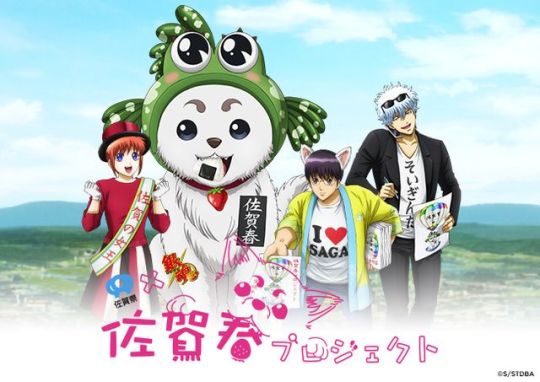




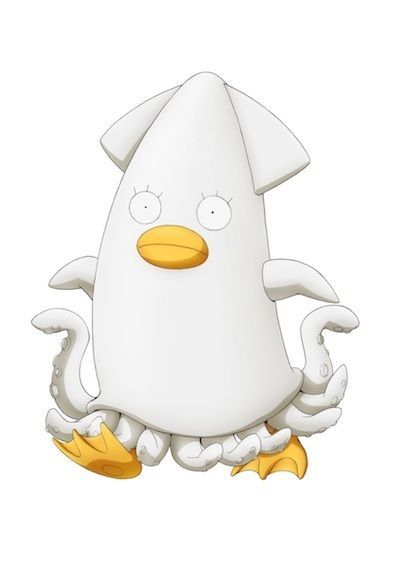

Character designs from 2018's Saga Prefecture x Gintama collaboration "Sagaharu Project" for Saga's Sagaprise campaign.
Sleazy producer Sakata-P promotes his dog as Saga's newest mascot. Sadaharu is wearing a mudskipper hat and a strawberry collar, sits in an Akita ware bowl, and is eating a riceball made with rice and seaweed produced in Saga. The name tag reads "Sagaharu".
There were Gintama-themed food, hot spring promos, a recording featuring Gintoki, another of Hijikata and Okita (promoting local mayonnaise and seaweed), and special regional goods. There was even a statue in front of Saga Station.

Katsura, in Yayoi period dress, was of course on standby at Yoshinogari Historical Park, ready to help with the PR campaign. Will Elizabeth get a statue, too?
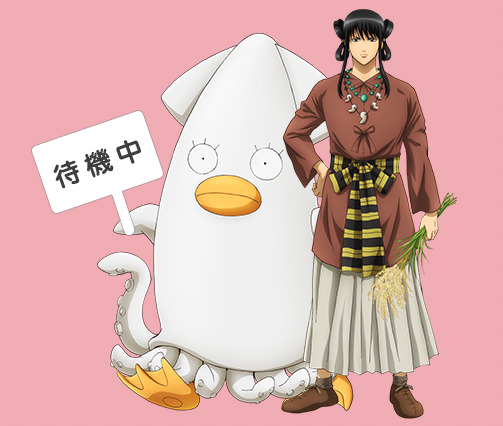
#gintama#sakata gintoki#sadaharu#shimura shinpachi#kagura#katsura kotarou#elizabeth#i saw a pic of zura looking stylish and found this.#saga prefecture
45 notes
·
View notes
Text
History with Conan: Japan’s Yayoi Period (The Yayoi Diet)
Yayoi people ate many of the same things as Jomon people: animals, fish, shellfish, and nuts. But with the spread of rice cultivation, rice was now on the menu as well. But it wasn’t eaten every day in larger amounts like rice in modern Japan. Rice was still valuable enough that it was often mixed into things like porridge, made with what are called the five grains: wheat, rice, beans, and two types of millet (awa and hie). This information comes from the Nihon Shoki, a Japanese history book from 720 CE. Grains like rice are very nutritious and can be grown in large amounts in a small area, so the Yayoi people could support a higher population across Japan than the Jomon people, who relied on the whims of nature.

The five grains, clockwise from top right: awa, beans, hie, wheat. Center: rice.

A Yayoi feast!
Top row, left to right: sake, rice porridge, shellfish soup, fruits
Middle/bottom row: vegetables, acorn dango, fish, meat, nuts

Ayumi: They didn’t have chopsticks yet, so they ate with their hands or with wooden spoons!
With illustrations and information from History Detective Conan 2: Yayoi Period (The Lonely Little Queen).
Next Time: The Yoshinogari Site
Kofi Tip Jar
3 notes
·
View notes
Text
Die erste Präfektur, die wir auf Kyushu angesehen haben, war Saga.
Weil wir besonders beim Fahren gerne sparen, gingen wir von unserem AirBnB aus erst einmal eine halbe Stunde zum günstigsten Busbahnhof. Mit einem 4-Fahrten Ticket haben wir sogar ein richtiges Schnäppchen gemacht und konnten für 1800 Yen (ca. 13€) hin und zurückfahren 😌 Hat dann auch 90min gedauert, aber das war schon okay.
In Saga angekommen, machten wir uns zuerst auf zur Burg, etwa 25 Minuten zu Fuß entfernt. Davon steht nur noch so ein Viertel, aber die kann man kostenlos besuchen. Spenden sind möglich und erwünscht, aber die Box steht da relativ unauffällig am Anfang und niemand weist einen da aktiv drauf hin.



Innen sind die Räume nach historischem Vorbild restauriert und werden als Museum verwendet, was tatsächlich recht viele interaktive und multimediale Angebote hatte. Mein persönlicher Favorit war so eine Art Straßenansicht wie bei Google Maps, bei der man mit einem Joystick durch die Burg navigieren konnte, keine Ahnung, wieso 😂

Es bestand sogar die Möglichkeit, sich über einen QR Code einen Guide auf dem Handy anzeigen zu lassen, der die Räume bzw. Objekte näher erklärt (4 oder 5 Sprachen glaube ich, Englisch war auf jeden Fall dabei). Die Filme hatten auch immer englische Untertitel 😳

Dann sind wir noch schnell beim naheliegenden Schrein vorbeigehüpft und haben uns dann auf dem Weg zum historischen Park Yoshinogari begeben. Das ist so eine Art Ausgrabungsstätte/Freiluftmuseum, wo man sieht, wie die Menschen so ca. 300 vor bis 300 nach Christus gelebt haben. War eigentlich auch gar nicht so uninteressant und es ist schon immer heftig, wie verhältnismäßig fortschrittlich die Häuser und Lagerräume und so allesgebaut wären. Und obwohl das Parkgelände echt weitläufig ist, sind wir immer wieder auf diese eine Grundschulklasse getroffen, als hätten sie und verfolgt, die kleinen Gören (haben sie nicht, die hatten eine Tour gebucht, aber es fühlte sich so an!) 🤨



Da wir aber ja noch 90min zurückfahren mussten, haben wir uns dann auf den Weg zum Hauptbahnhof gemacht. Schon in der Bahn dahin dachten wir, dass das sehr eng wird, wir sollten um 16:53 ankommen und der Bus fuhr 2min später. Aber den mussten wir ja erst mal noch finden 😅 War aber alles gut ausgeschildert, also haben wir minimal gehetzt und konnten tatsächlich gerade so noch hinter den letzten Leuten einsteigen 😂

Damit hätten wir dann also unsere erste Präfektur auf Kyushu bereist 😊 Ich weiß gar nicht, ob ich das erzählt hatte, aber hier hat jede Präfektur ein eigenes Gullideckel-Design, manchmal haben sogar Städte ein individuelles. Chiara und ich sind fleißig am sammeln, aber wir werden schon manchmal komisch angeschaut, wenn wir die fotografieren 😂
0 notes
Photo

[57/200] Kozukue Castle Ruins (2022-09-16) With Relive video! https://www.relive.cc/view/vdOR4DNj1Kq It's time for my yearly trip to Tokyo! While Tokyo Game Show is the main reason for the excursion, I figured I might as well try and fit some additional activities here and there when the schedule allows it. Of course, this included the usual Castle hopping. Normally I would use the Aki no Norihoudai ticket for this purpose, but this year I couldn't really find the right timing as work also had a decent amount of priority. As such, the couple of castles I will visit this weekend here will be the final ones for the year. Since I took a night bus to Tokyo, I arrived around 6AM in the morning, leaving enough time to squeeze in a visit to the Kozukue Castle Ruins in Yokohama, the Tokyo's friendly neighbour. But these castle ruins were all but friendly. The lack of maintenance led to mosquitoes swarming freely in the area; I couldn't take a single picture without getting bitten at least once. I also couldn't take a few steps without running in a huge spider web. I thought spiders were the natural predators of mosquitos but it seemed they have forged an unholy alliance against me. Ultimately I left with itchy arms and legs. Absolutely the worst experience I've ever had, especially considering there wasn't much to see here anyway. In my frustration I decided to kill the time and seek out other interesting tourist attractions nearby. Google Maps informed me of an "ancient village with rebuilt dwellings" called Otsuka-Saikachido Iseki Park, that one piqued my interest. At a 6 kilometer distance it wasn't exactly nearby, but I didn't really have better options in Yokohama otherwise. It turned out to be a pretty cool park, basically a taste of what you can find at Yoshinogari Park in Saga for free. Several elementary school groups were having a culture day over here as well, making it quite a wholesome experience. But I repeat for future me: do not go for excessive walks or hikes before Tokyo Game Show. I regretted it and I will regret it again. #小机城 #大塚歳勝土遺跡公園 #青春18きっぷ #お城巡り #日本100名城 #続日本100名城 #kozukuecastle #otsukasaikachidorelicspark #japanesecastle #japanphoto https://www.instagram.com/p/CohPYHyrJ1s/?igshid=NGJjMDIxMWI=
#小机城#大塚歳勝土遺跡公園#青春18きっぷ#お城巡り#日本100名城#続日本100名城#kozukuecastle#otsukasaikachidorelicspark#japanesecastle#japanphoto
0 notes
Photo

佐賀、吉野ヶ里 . Hello world🐅 Tag Japanophile😀 . Follow @toratabix For your Japanese trip someday. . #佐賀 #佐賀旅行 #吉野ヶ里 #遺跡 #saga #yoshinogari #ruins #寅旅 #旅行 #写真撮ってる人と繋がりたい #ファインダー越しの私の世界 #写真好きな人と繋がりたい #カメラ好きな人と繋がりたい #旅行好きな人と繋がりたい #カメラ女子 #カメラ #一眼レフ #キャノン #散歩 #絶景 #風景写真 #ひとり旅 #男はつらいよ #toratabi #instaphoto #travelgram #instatravel #photooftheday #instadaily #photography (吉野ケ里遺跡) https://www.instagram.com/p/ByMyr_pgL84/?igshid=1ao9coqdm7e6x
#佐賀#佐賀旅行#吉野ヶ里#遺跡#saga#yoshinogari#ruins#寅旅#旅行#写真撮ってる人と繋がりたい#ファインダー越しの私の���界#写真好きな人と繋がりたい#カメラ好きな人と繋がりたい#旅行好きな人と繋がりたい#カメラ女子#カメラ#一眼レフ#キャノン#散歩#絶景#風景写真#ひとり旅#男はつらいよ#toratabi#instaphoto#travelgram#instatravel#photooftheday#instadaily#photography
0 notes
Photo

Tea plants pruned into neat, round bushes, on the grounds of the Ryōsen-ji Temple, in Yoshinogari, Saga prefecture, Japan.
Photo by Pekachu, Wikimedia Commons, CC BY-SA 4.0.
1 note
·
View note
Photo



Yayoi reconstructions, up close
#japan#yoshinogari#history#architecture#building#wood#natural#archeology#anthropology#sagaken#roadtrip#kyushu#park
50 notes
·
View notes
Text
Daily dose of Koubenians #8
Welcome to your daily dose of koubenians. We showcase some of our best art every day.
Aya at Yoshinogari

Sekibanki & Kogasa

Parsee & Friends

Don't Forget, You're Here Forever

#touhou#touhou project#東方project#touhou fanart#tegakidraw#artists on tumblr#kouburepost#illustration
40 notes
·
View notes
Text
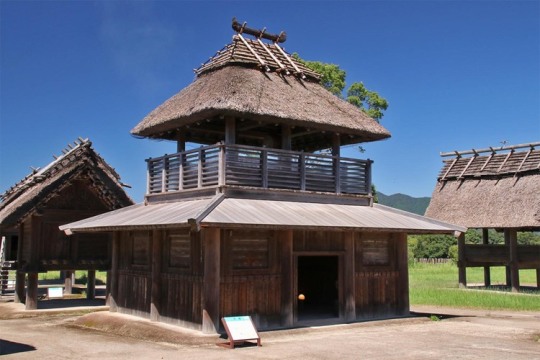

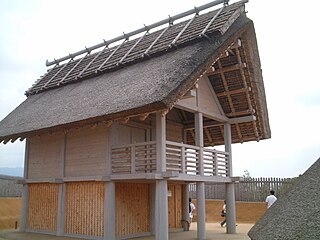


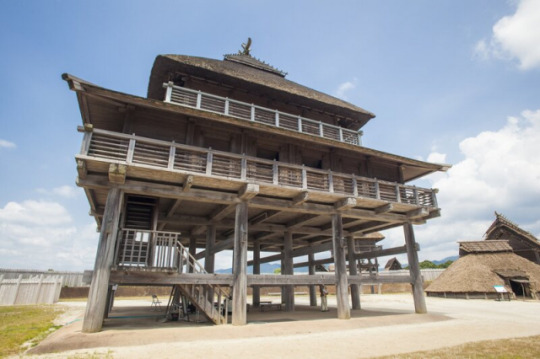
Sean bienvenidos, japonistasarqueológicos, a una nueva entrega de arqueología nipona, una vez dicho esto pónganse cómodos qué empezamos. - Nos volvemos a trasladar a la prehistoria japonesa que, cada día, nos sorprende con un nuevo hallazgo arqueológico. Las ruinas de Yoshinogari, datan del periodo Yayoi(III-IV) pero en este caso del Yayoi tardío y se localizan en la prefectura de Saga¿Cuándo llegó el arroz a japón? Y¿por dónde llegó? Hay dos teorías: una que llegó de china y la otra desde Corea hasta la isla de Kyushu a través del mar de Ariake. El enorme asentamiento está rodeado por tres fosos y es la raíz de los castillos en Japón, ha sido seleccionado como uno de los 100 castillos más famosos de Japón. - En el periodo Yayoi, se caracteriza porque es cuando aparecen las clases guerras y las clases dirigentes a raíz de la acumulación de poder, esto corresponde a los jefes locales, por ejemplo: La residencia de la clase dominante en el recinto interior sur, no confundir con realeza japonesa, hay que recordar que a los poblados se les instalaba un punto religioso, por aquella época predominaba el Sintoismo como: es el caso del santuario principal construido en el recinto interior norte. - El yacimiento cuenta con atalaya del recinto interior sur, de carácter defectivo, al sur se encuentra el pueblo con viviendas tipo foso y almacenes para guardar el arroz rojo que era el que se cultivaba en aquella época y en la ciudad de Karatsu, también en la prefectura de Saga, se encuentran las ruinas de Nabatake, las ruinas de cultivo de arroz más antiguas de Japón. - Durante el periodo Yayoi y Kofun tuvieron lugar una serie de migraciones desde la península de corea, esto trajo consigo que las poblaciones coreanas y japonesas de la zona se mezclaran generando mestizos, además de transmitir sus conocimientos de la agricultura. - Espero que os haya gustado y nos vemos en próximas publicaciones, que pasen una buena semana. Welcome, Japanese archaeologists, to a new instalment of Japanese archaeology, so make yourselves comfortable and let's get started. - We move back to Japanese prehistory, which surprises us every day with a new archaeological find. The ruins of Yoshinogari, dating from the Yayoi period (III-IV) but in this case from the late Yayoi period, are located in the prefecture of Saga When did rice arrive in Japan? And where did it arrive? There are two theories: one that it came from China and the other from Korea to the island of Kyushu via the Ariake Sea. The huge settlement is surrounded by three moats and is the root of castles in Japan, it has been selected as one of the 100 most famous castles in Japan. - The Yayoi period is characterised by the emergence of the warring and ruling classes as a result of the accumulation of power, this corresponds to the local chiefs, for example: The residence of the ruling class in the southern inner precinct, not to be confused with Japanese royalty, it should be remembered that the villages had a religious point installed, at that time Shintoism predominated, such as the main shrine built in the northern inner precinct. - The site has a watchtower in the southern inner enclosure, which is defective, to the south is the village with moat-like dwellings and warehouses for storing the red rice that was cultivated at the time, and in the town of Karatsu, also in Saga Prefecture, are the ruins of Nabatake, the oldest rice cultivation ruins in Japan. - During the Yayoi and Kofun period a series of migrations from the Korean peninsula took place, which resulted in the mixing of the Korean and Japanese populations in the area and the passing on of their knowledge of agriculture. - I hope you liked it and see you in future posts, have a good week.
#日本#韓国#考古学#遺跡#佐賀県#九州#歴史#先史#新石器時代#文化#吉野ヶ里遺跡#地理#弥生時代#有明海#唐津市#鍋岳遺跡#ユネスコ#photo#japan#archaeology#archaeologicalrests#Prefectureofaga#Kyushu#history#prehistory#neolithic#riceculture#Yoshinogariruins#geography#yayoiperiod
36 notes
·
View notes
Photo









Yoshinogari Historical Park today, including the mirror I made.
#photos#japan 2019#photos: japan 2019#places: yoshinogari#photos: scenery#photos: shrines/temples/castles
22 notes
·
View notes
Text
History with Conan: Japan’s Yayoi Period (The Yoshinogari Site)
Yoshinogari Historical Park is the site of a Yayoi moated settlement in Yoshinogari, Kanzaki District, Saga Prefecture. It’s the largest Yayoi settlement, at the size of 22 Tokyo Domes (1040000 square meters, 11190000 square feet), with the settlement at the center. The reconstructed buildings include a shrine, a royal residence, watchtowers, raised-floor storehouses, and pillar-supported buildings. Like the Jomon Sannai Maruyama Site, you can visit this to see it for yourself.
Map of the Reconstruction
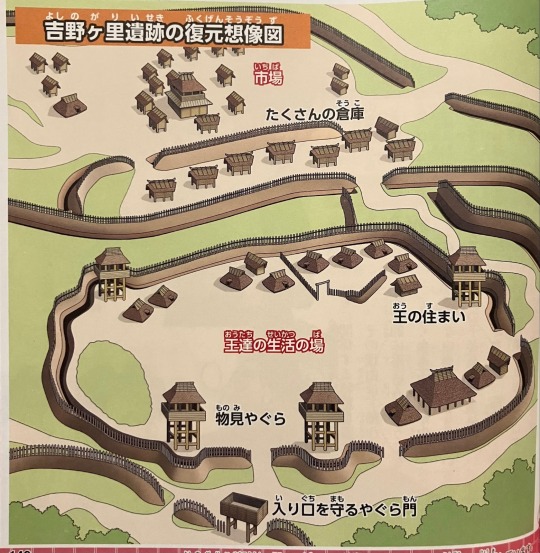

In the top left, there are many storehouses and a marketplace (indicated in red). Below that is an area for royalty, with a royal residence (to the right) and watchtowers. At the bottom of the map, we can see a watchtower gate guarding the entrance. On the right is the center where festivals and important meetings would have been held. The entrance near the bottom twists to make it hard for large groups to enter quickly in case of an attack. Two sets of walls and moats surround this area, though the moats were empty. There are watchtowers here too. Near the top we have a building used for festivals (rightmost label) and the main shrine.
With illustrations and information from History Detective Conan 2: Yayoi Period (The Lonely Little Queen).
Next Time: Yayoi Kids
Kofi Tip Jar
2 notes
·
View notes
Photo






吉野ヶ里遺跡15:11-15:23 15:33-16:50長崎 Yoshinogari heritage park15:11-15:23 Saga Saga15:33-16:50 Nagasaki. 885系 SM3。2001年ブルネル賞ブルネル賞、グッドデザイン賞。長崎本線かもめ。佐賀 予定では100名城佐賀城も検討していたのですが、結構暑かったので、またの機会にとっておくことにしました。佐賀には恵比寿様が日本一あるんだろそうです。I skipped Saga sightseeing in this time. Saga castle is the 100 greatest castle need to get a stamp.
0 notes



